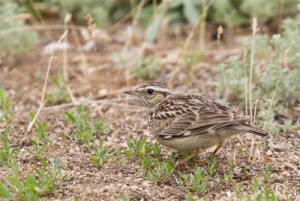 Almost everyone probably knows the warbling of this tireless champions of the songs in the sky. It is such a welcome sign of spring, that we all must look up in the sky involuntarily and have a look after the singer. That’s not that simple. And how many of us have seen recently larks in the last years. Besides the frequent Skylarks (Alauda arvensis) you might see Woodlarks (Lullula arborea) in Germany and – becoming more and more rare – sometimes Crested Larks (Galerida cristata), too.
Almost everyone probably knows the warbling of this tireless champions of the songs in the sky. It is such a welcome sign of spring, that we all must look up in the sky involuntarily and have a look after the singer. That’s not that simple. And how many of us have seen recently larks in the last years. Besides the frequent Skylarks (Alauda arvensis) you might see Woodlarks (Lullula arborea) in Germany and – becoming more and more rare – sometimes Crested Larks (Galerida cristata), too.
To observe their behavior close-up is difficult because all larks are characterized by a modest plumage. The gray-brownish color allows the birds mainly reside on the ground while remaining almost undetected. On the ground, these songbirds are quiet. Only with the flight song larks draw attention. In this special environment obviously they feel free to express themselves and promote their fitness. In the sky, they are not so vulnerable to the many predators who normally chase for them. On the ground, however, larks move usually in a stop-and-run motion. To check the environment they stop at a higher patch of grass or a stone. Woodlark one sees sometimes even sitting on bushes or lines.
Larks in general walk on the ground in search of food. They feed on insects and the rest of seeds, which are still left over from the previous year. Ornithologists suspect that it is mainly the males who arrive with the first migration wave and try to occupy the best breeding grounds. The females then follow a few weeks later. This is also the case with many other migratory birds.
As its congener the Wooklark show a gray-brown color. Back plumage is light brown and has stripes on; the belly plumage is white, the breast covered with light brown stripes. The woodllakr is not so strongly built as the Skylark and its size is samller. A characteristic feature of the Woodlark are the the white edges of the tail feathers and the white primary-covert bar, which is prominently shown in flight.
Hesitantly at first, but then with full volume in the last days. Spring is arriving. The air is filled with a melodious song. The first warm days will come, and thus the spring take the helm.
In Eastern Europe Larks are still more common to find. After decades of intensive agriculture with insecticides and chemical weed control they have become a rarity in the cultural landscape of western Europe.